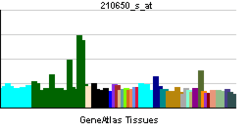PCLO
| View/Edit Human | View/Edit Mouse |
Protein piccolo is a protein that in humans is encoded by the PCLO gene.[4][5][6]
Function
Synaptic vesicles dock and fuse in the active zone of the plasma membrane at chemical synapses. The presynaptic cytoskeletal matrix (PCM), which is associated with the active zone and is situated between synaptic vesicles, is thought to be involved in maintaining the neurotransmitter release site in register with the postsynaptic reception apparatus. The cycling of synaptic vesicles is a multistep process involving a number of proteins (see MIM 603215). Among the components of the PCM that orchestrate these events are Bassoon (BSN; MIM 604020), RIM (RIMS1; MIM 606629), Oboe (RIMS2; MIM 606630), and Piccolo (PCLO).[supplied by OMIM][6]
Interactions
PCLO has been shown to interact with GIT1.[7]
Clinical relevance
Recurrent mutations in this gene have been associated to cases of diffuse large B-cell lymphoma.[8]
References
- ↑ "Diseases that are genetically associated with PCLO view/edit references on wikidata".
- ↑ "Human PubMed Reference:".
- ↑ "Mouse PubMed Reference:".
- ↑ Cases-Langhoff C, Voss B, Garner AM, Appeltauer U, Takei K, Kindler S, Veh RW, De Camilli P, Gundelfinger ED, Garner CC (Mar 1996). "Piccolo, a novel 420 kDa protein associated with the presynaptic cytomatrix". European Journal of Cell Biology. 69 (3): 214–23. PMID 8900486.
- ↑ Nagase T, Ishikawa K, Miyajima N, Tanaka A, Kotani H, Nomura N, Ohara O (Feb 1998). "Prediction of the coding sequences of unidentified human genes. IX. The complete sequences of 100 new cDNA clones from brain which can code for large proteins in vitro". DNA Research. 5 (1): 31–9. doi:10.1093/dnares/5.1.31. PMID 9628581.
- 1 2 "Entrez Gene: PCLO piccolo (presynaptic cytomatrix protein)".
- ↑ Kim S, Ko J, Shin H, Lee JR, Lim C, Han JH, Altrock WD, Garner CC, Gundelfinger ED, Premont RT, Kaang BK, Kim E (Feb 2003). "The GIT family of proteins forms multimers and associates with the presynaptic cytomatrix protein Piccolo". The Journal of Biological Chemistry. 278 (8): 6291–300. doi:10.1074/jbc.M212287200. PMID 12473661.
- ↑ Lohr JG, Stojanov P, Lawrence MS, Auclair D, Chapuy B, Sougnez C, Cruz-Gordillo P, Knoechel B, Asmann YW, Slager SL, Novak AJ, Dogan A, Ansell SM, Link BK, Zou L, Gould J, Saksena G, Stransky N, Rangel-Escareño C, Fernandez-Lopez JC, Hidalgo-Miranda A, Melendez-Zajgla J, Hernández-Lemus E, Schwarz-Cruz y Celis A, Imaz-Rosshandler I, Ojesina AI, Jung J, Pedamallu CS, Lander ES, Habermann TM, Cerhan JR, Shipp MA, Getz G, Golub TR (Mar 2012). "Discovery and prioritization of somatic mutations in diffuse large B-cell lymphoma (DLBCL) by whole-exome sequencing". Proceedings of the National Academy of Sciences of the United States of America. 109 (10): 3879–84. doi:10.1073/pnas.1121343109. PMC 3309757
 . PMID 22343534.
. PMID 22343534.
Further reading
- "Toward a complete human genome sequence". Genome Research. 8 (11): 1097–108. Nov 1998. doi:10.1101/gr.8.11.1097. PMID 9847074.
- Wang X, Kibschull M, Laue MM, Lichte B, Petrasch-Parwez E, Kilimann MW (Oct 1999). "Aczonin, a 550-kD putative scaffolding protein of presynaptic active zones, shares homology regions with Rim and Bassoon and binds profilin". The Journal of Cell Biology. 147 (1): 151–62. doi:10.1083/jcb.147.1.151. PMC 2164979
 . PMID 10508862.
. PMID 10508862. - Fenster SD, Chung WJ, Zhai R, Cases-Langhoff C, Voss B, Garner AM, Kaempf U, Kindler S, Gundelfinger ED, Garner CC (Jan 2000). "Piccolo, a presynaptic zinc finger protein structurally related to bassoon". Neuron. 25 (1): 203–14. doi:10.1016/S0896-6273(00)80883-1. PMID 10707984.
- Fenster SD, Garner CC (2002). "Gene structure and genetic localization of the PCLO gene encoding the presynaptic active zone protein Piccolo". International Journal of Developmental Neuroscience. 20 (3-5): 161–71. doi:10.1016/S0736-5748(02)00046-1. PMID 12175852.
- Takao-Rikitsu E, Mochida S, Inoue E, Deguchi-Tawarada M, Inoue M, Ohtsuka T, Takai Y (Jan 2004). "Physical and functional interaction of the active zone proteins, CAST, RIM1, and Bassoon, in neurotransmitter release". The Journal of Cell Biology. 164 (2): 301–11. doi:10.1083/jcb.200307101. PMC 2172332
 . PMID 14734538.
. PMID 14734538.


